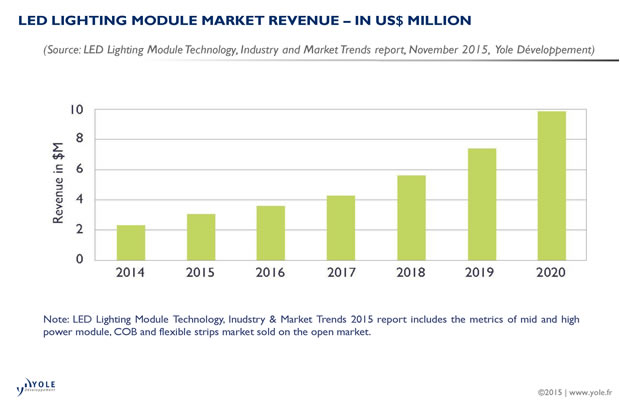Strategies to win LED packaging 'competition'
Within a highly competitive landscape due to a strong price pressure, most LED companies are looking for business opportunities and adopt different strategies of development. Vertical integration, product, application and activity diversification… New relays of growth are required for LED players to survive.
From a packaging point of view, more and more packaged LED manufacturers have selected the vertical integration strategy to move towards the module level and add more and more value in their LED components.
In the report entitled LED Packaging 2016: Market, Technology and Industry Landscape report, Yole Développement (Yole) reviews the LED industry and market status. Yole details process flows and related technologies in LED packaging. Yole proposes also a comprehensive analysis of the cost reduction and its impact at the LED packaging level.
According to Yole’s analysts, the packaged LED market represented a revenue of nearly $15.7bn in 2015. This industry should grow to a size of nearly $18.2bn by 2020.
Following the overcapacity caused by the recent LED TV crisis and the entry of Chinese players, industry consolidation was expected to decrease competition and stabilise price erosion. This eventually happened in China during 2014 and 2015, but with unforeseen effects on the overall industry. Indeed, several smaller players went bankrupt and many midsize players have since been acquired, leading to a situation where dozens of companies are having 'going-out-of business' sales. This has triggered strong price decline and, naturally, other LED players had no choice but to match the price trend initiated by the Chinese industry.
ASP for low and mid power LEDs declined 30-40% in the second half of 2015. In parallel ASP for high power LEDs, though less affected, still declined 20-30%. Globally, 2015 was a rough year for the LED industry, with packaged LED revenue declining for the first time ever: from $15.1bn in 2014 to $15bn in 2015.
This decrease was emphasised by lower-than anticipated demand in the LED backlight and LED lighting markets. Moreover, strong evolution in currency exchange rates due to the US dollar’s rise contributed to many players’ declining revenue.
2016 has seen the industry begin recovering, and packaged LED ASPs have mostly stabilised for highly-commoditised stock keeping units like the low-power 2835 and mid-power 5630.
Higher power grades for lighting applications are seeing increasing demand, but also stiffer competition, which likely will lead to a significant ASP drop as competition intensifies.
“Thus we expect the packaged LED market to show moderate growth in the coming years, reaching $18.5bn in 2021 (CAGR 2016-2021: +3.4%)”, explained Pars Mukish, Business Unit Manager, Yole.
LED packaging market is still a strong opportunity for materials suppliers. Indeed, LED packaging requires specific materials in agreement with application requirements.

Regarding packaging substrates, the high power density of devices induces the use of ceramic substrates, a market that will grow from nearly $684m in 2015 to $813m in 2021, according to Yole’s LED packaging report.
Encapsulant/optic materials will follow the same trend: Yole’s analysts announce $400m in 2015 and $526m in 2021. This market segment is driven mostly by the increased use of silicone material offering better reliability/lifetime than traditional epoxy material. In parallel, with major YAG IP expiring from 2017, the phosphor market will face strong commoditisation and price pressure. Consequently, market will only grow from nearly $339m in 2015 to $346m in 2021.
The LED packaging report (2016 edition) provides an overview of all LED packaging aspects. Each step of the packaging process flow including equipment and materials used is described, along with associated trends. Associated technological breakthroughs are also analysed.





